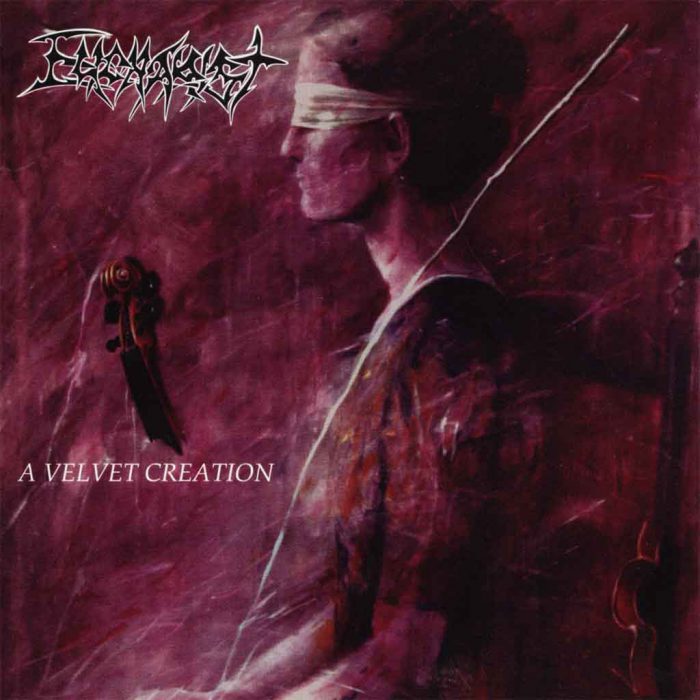Eucharist A Velvet Creation straddled the line between the metal of old and the “melodic death” metal that would ravage the Scandinavian scene. Intelligently the band still remained enough grit and the compositional maturity of the better genre while not being afraid to integrate an overt admiration for Iron Maiden and the occasional rhythmic tool. “Alone and Wounded” is a bonus track that manages to shape Melodic Death metal into what it should have been. The opening sequence however is so remarkable that it merits a closer look.
The entire melody is contained within the harmonic minor scale which is known for its darker Arabic sound. Here one guitar starts with a long melody that goes across the entirety of the scale while the other holds a few important notes to accentuate them. What differentiates this from many shredders and technically oriented bands is how the lead guitarist doesn’t adhere to any predefined pattern and seeks to create a verbose melody that doesn’t lose any of the dramatic catharsis that is typical of the band. “Technical” guitarists will play similar long patterns at higher speeds where each note becomes negligible and only the overall shape will convey a simple idea but this is of minor importance as the rhythm guitar will just play a simple riff to provide background noise while the lead guitar cycles through predefined reusable shapes. Eucharist avoid this through clever note selection. The riff descends across the scale and combines chromaticism with large interval leaps that don’t resolve the melody creating a sense of mystery. Each note is played twice in what could be seen as eight groupings of two notes. This keeps a fast pace to the melody while still allowing each note to remain completely intelligible as without the groupings the notes would fly far too quickly for their weight to be felt. The second guitar during the descent holds on to the root note two octaves higher before lowering down to the same note but an octave lower. This is played in two groups of sixteen notes with the goal of providing a fixed tonality for the somewhat chaotic descent. This gives direction to the descent.
The ascent played by the lead guitar is simultaneously within the harmonic minor scale and atonal. The ascent follows the diminished seventh arpeggio which is a series of minor thirds and since there is no variation in the intervals it becomes atonal as no root note can be discerned and therefore there is no tonality. The band counter this with the rhythm guitar playing the augmented seventh which holds the ascent firmly within the harmonic minor. Instead of releasing the tension the band delve deeper into more exotic territories which continues the momentum set up by the first two bars. The third bar takes the first bar but removes the opening fourth notes and ends with the fifth to end on a stable note that leads to the following passage. The fourth bar opts for finality as the lead guitar slightly changes the melody to avoid the previous descent. The rhythm guitar starts with the second bar of the descent and instead of ending on the root note, the melody goes through the augmented seventh and ends on the second in the same way the ascent started. This marks a climax to the short passage as all the ideas have been introduced then pushed to their logical limit before exploding in the final bar in this complex yet powerful instance.
This is one of the most fascinating introductions within death metal as so much effort is put into such a short sequence that plays with conventional harmony in a completely unexpected yet mesmerizing way. This takes from At the Gates and shows how rich the seeds they sowed were. On those four bars, Eucharist did more than what most bands could ever dream of doing.
Tags: a velvet creation, death metal, eucharist, riff analysis, wounded and alone



Counterpoint is one of the most interesting ideas to me musically. It is very difficult to achieve in death metal, less so in “melodic death metal” mainly because of the almost inherent requirement of a tonal center which allows the musicians less consideration over their note choices. The idea of having two independent melodies occupying the same space is a huge musical feat that very, very few bands have been able to achieve, especially beyond the level of pure Iron Maiden Mimickry (lots of early Gothenburg bands succumbed to this). Eucharist is one of the few bands who used the tonal center to bring a lot of different ideas that previous death metal bands (besides maybe ATG and Darkthrone on Soulside Journey) could not exploit as easily with their idiosyncratic and sometimes atonal scales. There are similar ideas found on the first Dark Tranquility album that are just as imposing; sadly the songwriting pales in comparison overall. Timeghoul are probably underrated for their use of melodic layering, although the purpose is different. The acoustic passage in “Greeting Immortality” taken from this album is another piece of note. Markus Johnsson, the lead guitarist, wrote a lot of the songs (and probably this song) when he was only 15 years old
Someone should contribute an article on here specifically to the best examples of counterpoint in metal music.
Big T in the house! Maybe you should be the one to contribute that article Mr. Timberlake, I bet you’re a fuckin NERD and listen Bach’s chorale work ;)
right? i couldnt even make it through the second sentence.
Not fair to compare this to lisping melodeath.
Although it is a mimicking of at the gates, it is executed well and the rythmic structures highlight their innovative take on the style.
There was an old underground legend that one of these guys went on to produce a lot of music for Brittany Spears. Could have been a tale tell, who knows
High iq blogpost